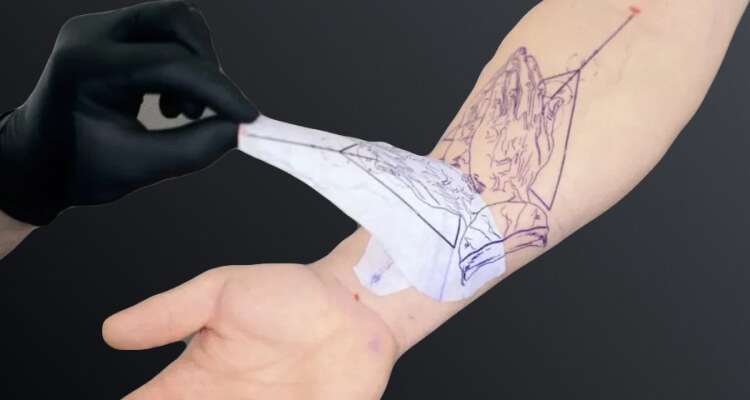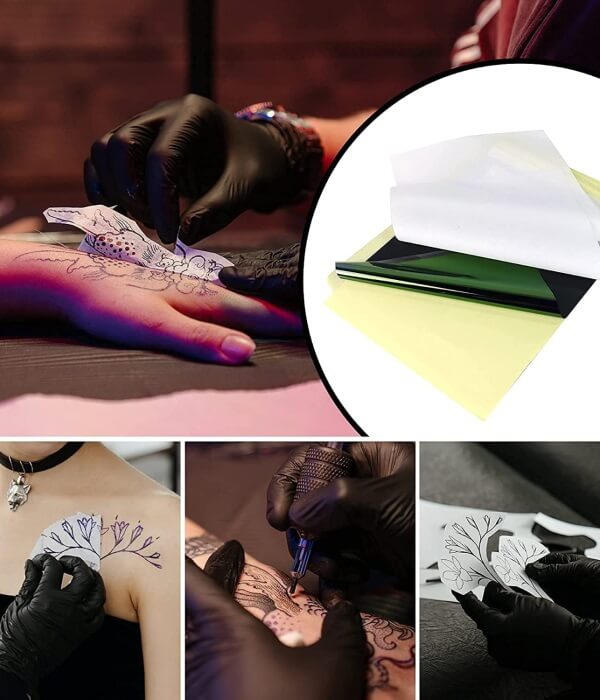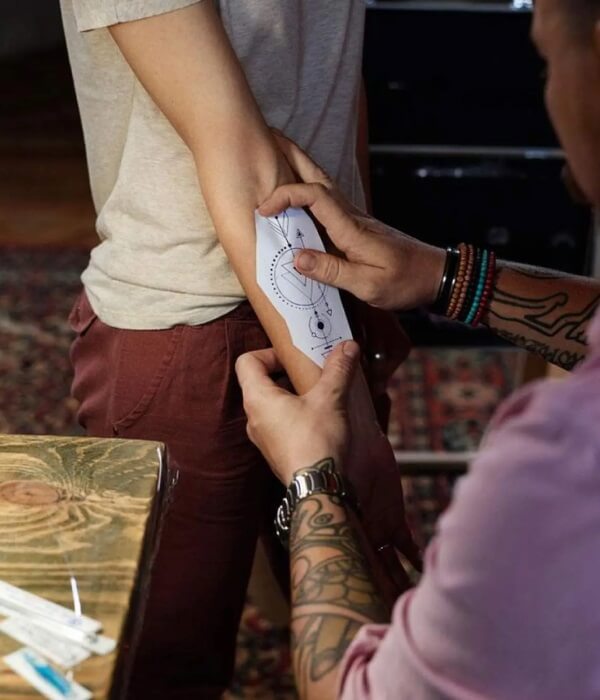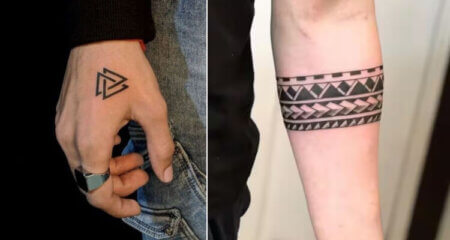
Free Tattoo Stencil Tips And Tricks: A Beginner’s Guide
Posted on
Tattooing is a beautiful journey but comes with its share of hardships, especially if it’s your first time doing it. Among the many useful tattoo tools, stencil is perhaps the most useful tool an artist can have in this field, as it allows an artist to carve clean, orderly, and professional tattoos, which is very important for beginners.
In this post, find free tattoo stencil tips and tricks for beginners when trying to perfect their stencil carving techniques. This tattoo stencil guide also highlights the different types of stencil papers and what a stencil paper is.
What is Stencil Paper?
Before knowing how to use stencil tattoo paper, one needs to understand what stencil paper is. Stencil paper is one of the specialized sheets used strictly in the process of tattooing. Its use is strictly to transfer a design onto the skin; it acts as a guide for the tattoo artist. The sheet usually possesses several layers: a protective sheet, a carbon or transfer layer, and a backing sheet. Tattoo artists can achieve accurate, detailed outlines for precise tattoo application when they trace or print designs onto stencil paper.
Types of Stencil Paper

For tattoo stencils, you will find 3 types of paper, each for a unique purpose. Here are the details about the main three types:
1. Thermal Stencil Paper
Thermal stencil paper is designed to be used on thermal printers and thus is an excellent tool to transfer intricate, detailed designs easily and accurately. It works by heating the paper, which activates the transfer layer and results in a very clear stencil on the skin. Such stencil paper is ideal for intricate tattoos, and it’s used in almost all professional studios for its precision and efficiency.
2. Hand-Tracing Stencil Paper
Hand-tracing stencil paper is another type of tattoo stencil for beginners and is considered a traditional method in which the picture is drawn on the stencil paper with the help of a ballpoint pen or styluses. Indeed, it is an easy and flexible process for achieving designs, basic or custom ones at that. It takes longer than thermal paper, but it can be easily managed personally to create the stencil, which makes it perfect for learners.
3. Freehand Stencil Paper
Freehand stencil paper can be used where no design has been previously drawn on the paper and the design can be drawn directly on the sheet. This option is conducive to artists who wish to design new tattoos and give their clients brand-new tattoos on the spot. It gives total design control and is commonly employed in designs where changes or customization are frequently made.
Preparing The Skin For Transfer
To have a successful stencil transfer as well as to keep the design intact during the tattooing process an important step is properly preparing the skin. Follow these steps:
- Clean the Skin: Gently wash the skin with antibacterial soap to clear away all dirt, natural oil, and sweat. Before using the stencil, you need to wash the skin to keep it pure.
- Shave the Area: Before painting your tattoo design, use a disposable razor to take off any hair from the area. Cleaning the area when shaving keeps the stencil evenly applied and helps it stay put on the skin.
- Disinfect: Using a medical-grade sanitising solution on the skin helps kill germs and stops infection.
- Dry the Skin: Use a soft, dust-free cloth to blot the skin dry so that your stencil can stick well.
- Apply Stencil Solution: Use a proper stencil transfer solution and wet the prepared area with the solution, only a thin coat is necessary. Use a light hand when putting on stencil solution, excessive pressure can make colours spread over the skin.
- Transfer the Stencil: Put the stencil on the skin and press gently to ensure even contact. Peel off the paper very gently, so that you’ll be left with the design on the skin.
- Let It Dry: Make sure the stencil has a full drying time before you start your tattoo. Using this method helps keep the design very sharp, with less chance of rubbing off when working.
Tattoo Stencil Tips and Tricks: Minimizing Smudging While Tattooing

Preventing smudging of the stencil while tattooing is very important for maintaining clean and sharp designs. Here are some beginner tattoo stencil tips and tricks to help:
1. Use a High-Quality Stencil Transfer Solution
Stencils are very delicate and can be ruined easily, smudging is also another problem that can be encountered during the tattooing process, the right stencil transfer solution therefore is very crucial. Professional-grade solutions assist the stencil to stick firmly to the skin and prevent it from shifting around. Avoid adding deodorant or you will get a weaker bond and risk your design being smudged. For best results, spread the solution thinly and equally to prevent over-moistening your design.
2. Allow the Stencil to Dry Completely
Lack of time to dry is one of the most known reasons for smudging the stencil. When applying the stencil wait for some time to make sure it sticks on the skin before you start tattooing. Rushing this part lets ink easily run off or spread incorrectly when colouring. The speed and amount of time the stencil needs to dry vary, so check product recommendations.
3. Work in Sections
This means you should do one tiny piece of the design at a time instead of trying to cover a big area all at once. This will prevent touching or smudging the parts of the stencil that haven’t been tattooed yet. To keep clean work, begin drawing designs from the top of the page and be aware not to let your hands or tools drop ink on areas you haven’t touched yet.
4. Keep Gloves and Hands Clean
While working on a tattoo, ink from your gloves can move onto the stencil and ruin it. For clean tattooing, always wipe gloves with a paper towel and rubbing alcohol and get new ones when they get too messy. Keep away from touching the stencil without the need to protect its clean look. It is recommended to touch the stencil area only when necessary to keep it clean and clear.
5. Use Gentle Wiping Techniques
Cleaning up excess ink during tattooing, use a soft damp paper towel and light pressure. Do not over-wipe the stencil, which will disrupt it. Rubbing too vigorously will destroy the design.
6. Avoid Sweaty or Friction-Prone Areas
Pick an area with less sweating or friction as much as possible. These would weaken the adhesion of the stencil and cause smudging. In case it is compulsory to get tattooed in these areas, take special care and use a waterproof adhesive sealant.
More Tattoo Stencil Tips and Tricks
keeping your hands in the right position, adjusting the light and camera spot, and knowing when to reapply the stencil is what make tattoos come out looking good. Keep your hands and wrists positioned carefully away from the stencil to stop accidental smudging. Keeping your hand and pressure consistent will help you work with both precision and keep the lining in place.
You need good lighting to see what you are doing and where you are marking the client and minimizing the risk of unintentional errors. Change how the light hits your workspace and reposition things to get rid of dark areas and shiny spots that affect your stencil view. This helps you draw with utmost precision.
You should stop drawing and put on a fresh stencil if the ink smears so badly that you can’t see the pattern. It’s better to stop and restamp the stencil than to ruin the quality of the tattoo. Take your time to reposition the design accurately, making sure it aligns with the original placement. Using these methods along with waiting and watching everything closely helps you improve your job while making sure your work looks good.
Conclusion
In conclusion, mastering tattoo stencils is a skill that any beginner needs to have, which forms the basis of clean and precise tattoos. The use of quality materials, preparation of the skin, and careful application of the stencil ensure a strong and lasting transfer. Techniques such as proper hand positioning, adjusting your workspace lighting, and knowing when to reapply the stencil all contribute to a smoother tattooing process.




![Trending Tattoo Designs for Girls [2024] Trending Tattoo Designs for Girls [2024]](https://www.trendingtattoo.com/wp-content/uploads/2024/09/Trending-Tattoo-Designs-for-Girls_1-450x240.jpg)


